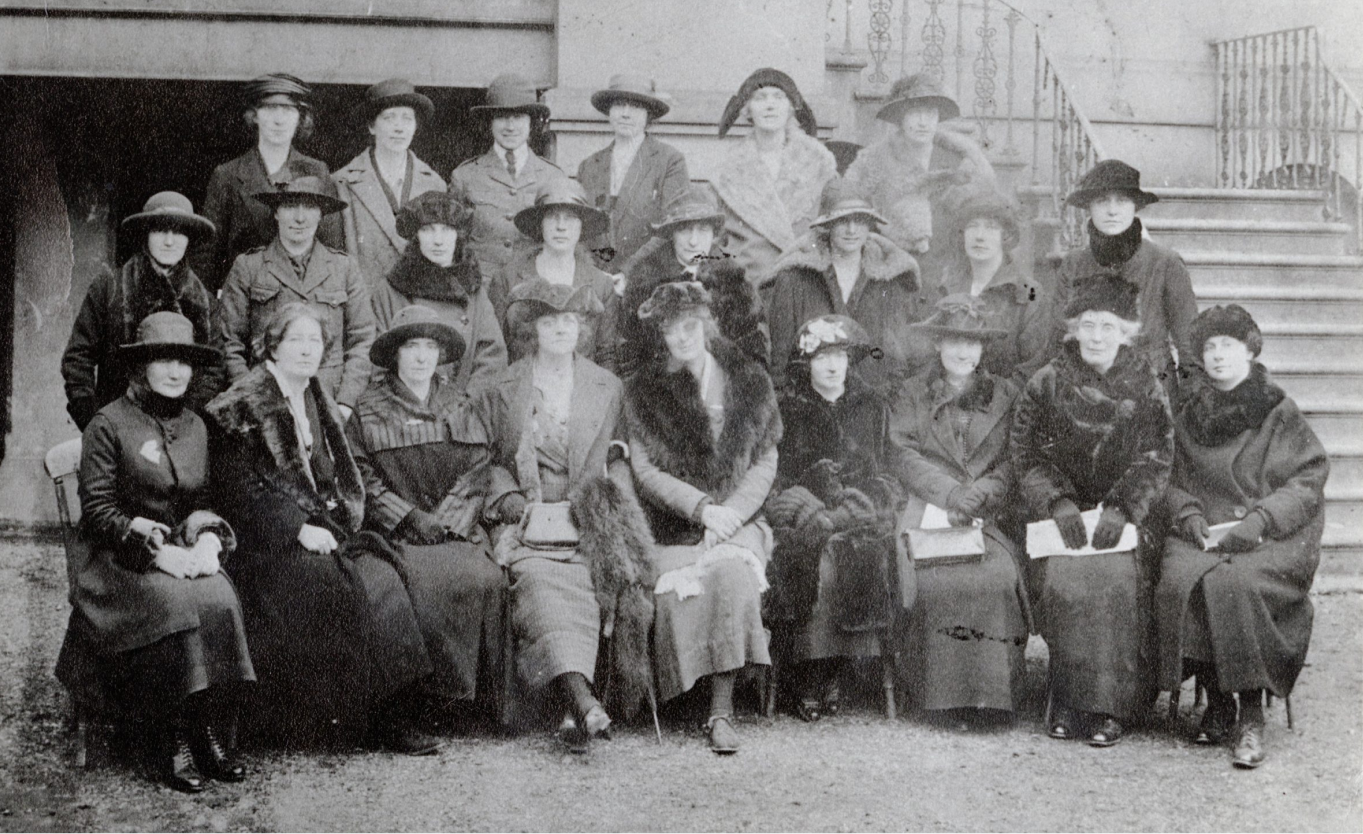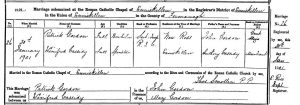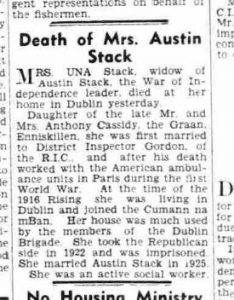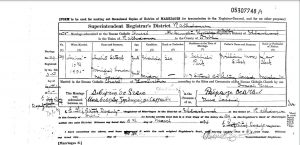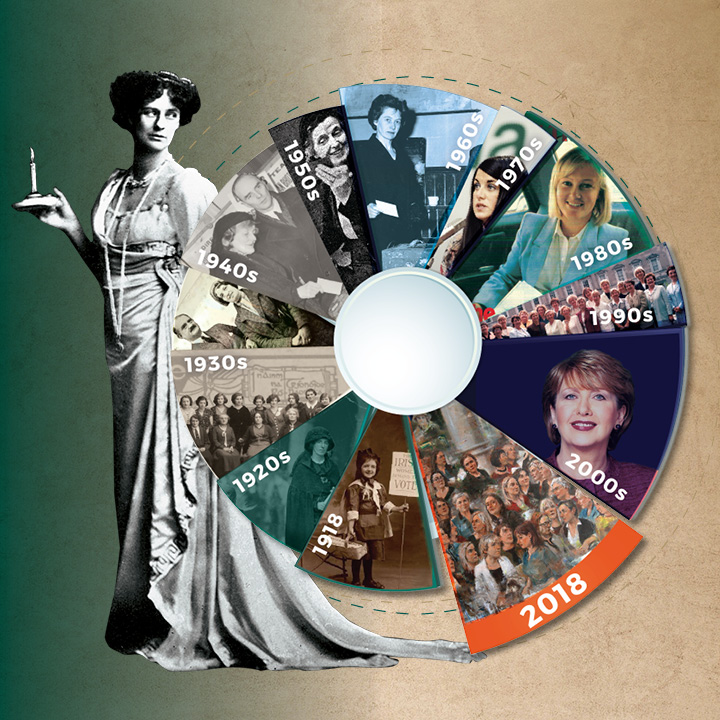‘She never failed to carry out all the orders, never faltered or failed, either in courage or reliability.’ MSP34REF21162
Máire Deegan was from County Wexford, she gave her address as Brideswell, Craanford, Askamore, Wexford. The daughter of Mary and James Deegan, she was from a family of eleven. She moved to Dublin, and she began working in a shop.
She was a member of Central Branch of Cumann na mBan, which she had joined on 15 February 1916. She was in Wexford for the Easter Holidays when she heard of the Rising and she cycled to Dublin. She reported to Jacob’s Factory but she was unknown to those in the garrison. She awaited orders at her cousins’ home in Wicklow Street. MSP34REF21162
After the Rising she was involved with the National Aid and the Prisoners’ Dependents’ Fund. She was part of the reorganisation of Cumann na mBan attached to the branch in Parnell Square. She was involved in electioneering in the General Election of 1918. During this period she was working in a sweet shop on George’s Street, and it was there that all the Cumann na mBan typed reports that were produced in Foley’s Typewriter Business in College Green were deposited there, according to Nancy Wyse Power. (Nancy Wyse Power, BMH Witness Statement 587).
In 1919 she opened a grocery shop in partnership with her friend Máire O’Neill. It was called An Stad located at 95 Upper Dorset Street and became ‘post office for the IRA’ for messages from all over the country, the messages were for both the IRA and Dáil Éireann. (Áine Ní Riain, BMH Witness Statement 887).
She was Commanding Officer of Cumann na mBan in Parnell Square. The Ryan sisters Áine and Éilis were attached to that branch, as well as Mary Rigney. Máire Deegan was involved in getting a cottage for Cumann na mBan in Howth in 1919. She was 1st Lieutenant, who both the Ryan sisters reported to. Máire Deegan was involved in the first session of Dáil Éireann at the Mansion House, she was able to get Áine Ryan a ticket to attend. (Áine Ní Riain, BMH Witness Statement 887).
In February 1919 when Kathleen Clarke was released from prison, Máire was one of those who was part of the welcoming reception for her hosted at the Gresham Hotel, identified by her family in the photograph from that event. Image KIlmainham Gaol, 19 PO-1A33-29.
The shop on Dorset Street also held all the papers for the Dáil Éireann Ministry of Labour whose Minister was Countess Constance de Markievicz. She also worked closely with Markievicz and according to her family she was a confidante. See: Dan Walsh, In Our Time, Women in the 1916 Rising, Wexford Echo, 15 April 1916, a transcript of the article can be found here. Her Black and Tan medal, (image on Alamy) has two bars showing active service.
She was close to all the prominent women of the period. In an account by Bridie O’Mullane, Máire Deegan apprehended a woman who had infiltrated Cumann na mBan as a spy, gave her a warning before sending her out of the country.
Máire took her share out of the shop in Dorset Street. In June 1921 she was ordered by Cumann na mBan to leave Dublin and become an organizer in her native Wexford. MSP34REF21162
She was co-opted into the Executive of Cumann na mBan in October 1920. She was re-elected in 1921. In October 1921 she became a full time official at the Headquarters of Cumann na mBan (MSP34REF21162 letter from Leslie Bean de Barra, 10 July 1937).
She opposed the Treaty. She was active in the fighting. According to Áine nÍ Riain ‘went everywhere with the fighting men’ but came back to Dublin often. When the fighting took place at the centre of Dublin in July 1922, she had made her way from Wexford to take part. (Áine Ní Riain BMH Witness Statement 887). She was stationed at Barry’s Hotel.
She was Director of Intelligence for Cumann na mBan from 1922. She was arrested on 14 November 1922, when she was arrested it was described as ‘a loss’. (Áine Ní Riain, BMH Witness Statement 887). Máire was imprisoned in Mountjoy Jail, Kilmainham Gaol and the North Dublin Union. She was part of the command structure within the prison. She was put in charge of hygiene, which was very important in the NDU as women were getting sick from the conditions to which they were subjected. She was one of the 22 women who escaped from the detention centre.
She continued in Cumann na mBan and continued as Director of Intelligence until 1927. Yet when she was interviewed she states that she called a convention of Cumann na mBan but did not do anything else. When asked did they not come looking for her after her release, she said ‘No. They probably had enough of me.’
She was in ill health following her imprisonment.
She later worked in the Hospital Trust (The Irish Sweepstakes).
She was awarded a pension in 1938. In her final years she lived at 113 St Stephen’s Green. Due to her ill health, she was moved to Baggot Street Hospital. There on 2 May she discovered that her father had died on 2 May. She died the following day on 3 May 1939 aged 51.

Members of Old Cumann na mBan lined the route from the hospital to the Carmelite Church on Clarendon Street. The coffin was draped with the Tricolour.
She is buried in Askamore Cemetery, County Wexford.
